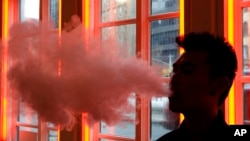Electronic or e-cigarettes, marketed as a safer alternative to actual tobacco-filled smokes, have prompted a dramatic increase in the number of calls to US poison control centers. Most of the calls were from those worried about children who played with the mock cigarettes.
Two hundred fiteens people called U.S. poison control hotlines about e-cigarettes in February, according to a report by the US Centers for Disease Control and Prevention, or CDC. There was just one call to a center in September 2010, when the product was still new.
More than half of the emergency hotline calls were reports about children ages five and younger who were sickened by the battery-powered devices.
Tim McAfee is director of the CDC’s Office on Smoking and Health. He says e-cigarettes, which are unregulated, contain liquid laced with nicotine, the addictive substance in cigarettes. He says nicotine in liquid form is a well-known hazard.
“Nicotine historically has been used as a pesticide in the United States. And that’s where we have really had for many, many decades significant poisonings when people got exposed to nicotine that was in liquid solutions," said McAfee.
All e-cigarettes emit an aerosol that mimics cigarette smoke. But McAfee says some e-cigarettes are just inhalable cartridges that the user refills with nicotine solution. Nicotine can be absorbed by the skin and McAfee says poisoning commonly occurs if someone gets a small amount of the liquid on themselves, in their eyes or if the solution is swallowed.
Symptoms of nicotine toxicity include nausea and vomiting, abdominal pain, dizziness, unsteadiness, tremor, headache, muscle twitches and seizures. Excessive amounts of nicotine can disrupt heart rhythms, in rare cases leading to death.
Not surprisingly, the number of reported poisonings has risen with the popularity of e-cigarettes over the past several years. But McAfee says he doesn’t want concerns about e-cigarettes to deflect attention from the much more serious health hazard posed by cigarettes, which kill a half million Americans every year.
“So, cigarettes are the winner in that contest. And we don’t really know what’s going to happen with e-cigarettes," he said.
Because they don’t contain the hundreds of harmful chemicals found in burning tobacco, the U.S. Surgeon General has suggested that e-cigarettes may be a useful tool for adults trying to kick the cigarette habit.
But McAfee worries that teenagers, who may regard electronic cigarettes as harmless, could become hooked on the nicotine and eventually move on to real cigarettes.
Two hundred fiteens people called U.S. poison control hotlines about e-cigarettes in February, according to a report by the US Centers for Disease Control and Prevention, or CDC. There was just one call to a center in September 2010, when the product was still new.
More than half of the emergency hotline calls were reports about children ages five and younger who were sickened by the battery-powered devices.
Tim McAfee is director of the CDC’s Office on Smoking and Health. He says e-cigarettes, which are unregulated, contain liquid laced with nicotine, the addictive substance in cigarettes. He says nicotine in liquid form is a well-known hazard.
“Nicotine historically has been used as a pesticide in the United States. And that’s where we have really had for many, many decades significant poisonings when people got exposed to nicotine that was in liquid solutions," said McAfee.
All e-cigarettes emit an aerosol that mimics cigarette smoke. But McAfee says some e-cigarettes are just inhalable cartridges that the user refills with nicotine solution. Nicotine can be absorbed by the skin and McAfee says poisoning commonly occurs if someone gets a small amount of the liquid on themselves, in their eyes or if the solution is swallowed.
Symptoms of nicotine toxicity include nausea and vomiting, abdominal pain, dizziness, unsteadiness, tremor, headache, muscle twitches and seizures. Excessive amounts of nicotine can disrupt heart rhythms, in rare cases leading to death.
Not surprisingly, the number of reported poisonings has risen with the popularity of e-cigarettes over the past several years. But McAfee says he doesn’t want concerns about e-cigarettes to deflect attention from the much more serious health hazard posed by cigarettes, which kill a half million Americans every year.
“So, cigarettes are the winner in that contest. And we don’t really know what’s going to happen with e-cigarettes," he said.
Because they don’t contain the hundreds of harmful chemicals found in burning tobacco, the U.S. Surgeon General has suggested that e-cigarettes may be a useful tool for adults trying to kick the cigarette habit.
But McAfee worries that teenagers, who may regard electronic cigarettes as harmless, could become hooked on the nicotine and eventually move on to real cigarettes.




